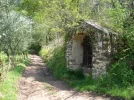Can Santiago as a destination be replaced???? Here is a "first of its kind in the United States."
Amid a patchwork of Wisconsin farmland half an hour's drive northeast of Green Bay is a modest shrine with a brick chapel, a school and a flow of pilgrims speaking of profound healing power.
The power is said to come from the Virgin Mary, who appeared to a Belgian immigrant 151 years ago where the shrine now stands. But all believers had to show for it were years of anecdotes — and the canes, wheelchairs and crutches left behind in the chapel's crypt by those who claimed they had been healed.
Now, the Roman Catholic Church has issued a decree: The apparition in 1859 was authentic.
Or as the Most Rev. David Laurin Ricken, bishop of the Diocese of Green Bay, said last week, the Shrine of Our Lady of Good Help is "worthy of belief."
With the bishop's approval, the landmark known mostly by locals has been elevated to the level of Marian apparitions in Mexico City, Fatima in Portugal, and Lourdes in France.
It is the first of its kind in the United States.
"This is an affirmation of the spiritual fruits the people of God have received for 151 years," Father John Doefler, the shrine's rector and the vicar general and chancellor of the diocese, said of the bishop's decree. "It opens the door for future spiritual growth."
The process to verify the apparition began in January 2009, when Ricken began an investigation. The diocese commissioned theologians to pore over the journals of the young woman who claimed to have been visited by Mary, as well as other records and accounts.
The researchers examined the woman's character and psychological health, and found that reported occurrences at the shrine, such as the healings, were in line with the teachings of the church.
Church declarations of Marian apparitions are a rarity, said Father Thomas Rausch, a professor of theology at Loyola Marymount University in Los Angeles. With so many sightings reported — including some that may be happenstance, like Mary's face on a tortilla — the church handles such decisions carefully.
"Most Catholics are skeptical," he said, "so the church is reluctant."
There are only about a dozen church-confirmed Marian apparitions worldwide. In one case, a vision in Akita, Japan, was certified in 1988 by Cardinal Joseph Ratzinger, now Pope Benedict XVI, when he oversaw the Vatican office charged with preserving church doctrine.
Yet since 1900 alone, hundreds of sightings have been reported. In most cases, the church has not decided whether they are worthy of belief, according to the International Marian Research Institute at the University of Dayton in Ohio.
The church has resisted offering such decrees in recent years. The Bosnia-Herzegovina village of Medjugorje, where several young people claim to have seen the Virgin Mary multiple times since 1981, has drawn masses of pilgrims over the years. Still, the church has fended off calls to certify the apparition.
In Wisconsin, though, the bishop's decree means "the evidence of this is worthy of belief, but we can't be absolutely sure," Rausch said. Ricken must have "good evidence, or else he wouldn't make this declaration," he said.
In what is now just outside the small town of Champion, the church says, Adele Brise, a 28-year-old Belgian immigrant who had lost an eye in a childhood accident, was visited three times in October 1859 by the vision of a woman in white. In the third vision, as Brise carried grain to a mill, the woman identified herself as Mary.
The church said the vision hovered above the ground, cast in a bright light, and offered a mission to Brise: "I am the queen of heaven who prays for the conversion of sinners, and I wish you to do the same. You received the Holy Communion this morning and that is well. But you must do more."
The church said the Virgin Mary instructed Brise to spread Catholicism and pray for strengthening the faith of believers. After the command, Brise became a nun and helped to build a church in that space, along with a school.
The chapel and school still stand, which in itself could be considered miraculous. One of the largest recorded forest fires in history, the Peshtigo fire of 1871, raged through Wisconsin and Michigan, coincidentally at the same time as the Great Chicago Fire. Brise gathered a group at the shrine, and they prayed to Our Lady of Good Help for protection, the church said.
The fire burned through the fields and forests around them, but the blaze stopped as it reached the perimeter of the shrine.
Brise died in July 1896, and was buried near the chapel.
Bishop Ricken said the moral fiber Brise demonstrated throughout her life was the leading factor in his decision. "There is nothing in the person and character of Adele Brise that would question the veracity of the substance of her account," he said in the decree.
The shrine has built a reputation as a sacred place, attracting the sick and the troubled with prayers. Doefler said there were seemingly endless stories of terminal ailments disappearing and longstanding feuds and family struggles evaporating.
Its healing powers are what Michael Lee and his family believe cured his brother of a brain tumor more than 50 years ago. The boy couldn't walk because the tumor had taken away his balance.
Lee's parents drove to the Shrine of Our Lady of Good Help and, for nine days, walked on their knees around the altar of the shrine, petitioning for their son's tumor to heal.
A few days after their return, Lee said, his brother's balance returned. He could walk again.
His doctor was dumbfounded by what medical tests revealed: The tumor was gone. Lee said the doctor wrote to the bishop at the time, calling the recovery "medically unexplainable."
Lee, 58, who works as a lay minister at a parish in Green Bay, said the simple shrine held significance to his family.
"It was always there in the back of our mind, that if anything serious or important came up, that was a resource," Lee said. "It gives you this deep sense of hope. Even if the physical thing you came there wanting healed isn't. There is this feeling that there is something greater than us that gives, cares and loves."
rick.rojas@latimes.com




















